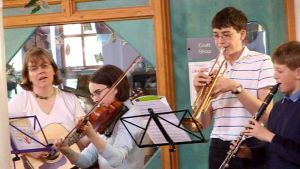Robert Harrison, vicar of St John's Hillingdon, and teams of people from the church have spent over a year planning for an innovative way of doing Sunday mornings. Here he answers questions local people might ask about how it works.
 What is 'Come & Go' worship?
What is 'Come & Go' worship?
It is exactly what it says: come when you can and go when you like. Our worship starts at 8am and continues all the way through to lunch at 12.30pm. You can arrive at any time in between, and leave whenever you wish.
Will I interrupt people if I arrive at the wrong time?
No. If you arrive in a quiet bit, it would help if you come in quietly, of course. But we are quite used to people arriving and leaving all through the morning.
Will people think I'm rude if I go half way through something?
Again, if you leave at a quiet moment, no-one will mind if you leave quietly. There is a planned opportunity to leave every half hour (at the end of each section), but you are welcome to leave at any stage.
Is there a minimum amount of time I will be expected to stay?
It is quite common for people to worship for one half hour section and then leave. But if you can only stay for five minutes, we will be pleased that you joined our worship, and believe God will too.
Occasionally, people stay for the full five hours. Those who have, have enjoyed the experience.
If I stay for a long time, will the worship start repeating itself?
Every half hour has a different style and approach. Each Sunday, a single theme runs through the morning's worship, but each section explores that theme in a different way.
You will get to look at the same aspect of Christian life and faith from many different perspectives.
I am used to worshipping in other Church of England churches. Will I get the kind of 'service' I am used to?
If you come from 8.00am to 9.00am, you will worship in a traditional, 'Book of Common Prayer – 1662' format.
If you come from 10.00am to 11.00am, you will find the worship similar to other services based on 'Common Worship – 2000'.
The worship from 11.30am to 12.30pm is contemporary, relaxed and interactive, while keeping within the guidelines of the Church of England.
Will I get a whole service every half hour?
That depends on what you mean by a 'whole service'. You will get a complete act of worship, but you will not get all of the ingredients that are commonly found in a Church of England service. The Come & Go program is designed so that you will get a fairly well-balanced spiritual diet if you stay for about one and half hours.
What style of worship will I find at St John's?
We do not believe that there is a 'right' way of worshipping God. (Jacob heaped up a pile of stones and poured oil on them; Moses roasted a sheep and ate it with his family and neighbours. King David wrote spiritual songs, and sacrificed bulls on a neighbour's farm; King Solomon did the same in a magnificent Temple. Jesus read the scriptures and discussed their meaning in a purpose-built synagogue; St Peter gathered Christians for regular communal meals in people's homes, and St Paul encouraged them to sing together and tell one another about God).
We purposefully offer a wide variety of worship styles so you can worship God in a way that suits your needs.
As a general rule, our Sundays begin with formal and traditional worship. As the morning progresses the style and content gradually become more informal and contemporary.
Are breakfast, coffee and lunch part of the worship, or gaps in the worship?
They are very much part of the worship. The very first worship gatherings of the Christian church took place over communal meals (not least of these were Jesus' Last Supper and his first meetings with his disciples after the Resurrection).
At St John's we have a strong emphasis on being a community of Christians. There are few things better for a community than eating together.
Do I have to pay?
In every half hour section there is an opportunity to make a financial offering. Making a significant offering from our income has been a vital part of Christian and Jewish worship all the way back to Abraham.
In the meal-centred sections, you will be invited to make a contribution towards your food. Any surplus money, after the costs have been met, will go into the general offering.
As St John's is a charity, we can claim tax back from the government if tax payers fill in a very simple form to register their gift.
 Where did the Come & Go idea come from?
Where did the Come & Go idea come from?
We live in an age of extended shop opening, flexible working hours and 24/7 entertainment. There are only a few things in our lives that require us to arrive at a particular time and stay until it is finished, unless we have booked in advance.
We want to make it possible for as many people as possible who want to worship God, to do so.
Does Come & Go worship make a lot of extra work for the church leaders?
No. Because each half hour section is self-contained, it has been possible to include a wider spectrum of church members in leading our worship. As a result, the clergy are now doing slightly less on a Sunday morning than they used to. They are also regularly able to take part in leading the children's worship.
Even the vicar is free to come & go when he is not directly involved in leading the worship.
How much planning goes into each Sunday morning?
All the people who leading the half-hour sections on any given Sunday meet together about ten days beforehand.
They discuss the Bible readings for that Sunday and decide on a relevant theme arising from those readings.
They then talk through how each of them will explore that Bible passage & theme in the section(s) they are leading.
Finally they agree on a 'conversation topic' which is used three or four times during the morning when worshippers have an opportunity to talk among themselves.
They then go home and continue their own prayer and preparation.
What happens in each of the half hour sections?
8.00am Morning Prayer: the traditional 'Prayer Book' service of 'Matins', slightly shortened, with prayers, Bible readings and ancient Psalms & Canticles (there is no singing at this time in the morning).
8.30am Traditional Communion: the Communion part of the Holy Communion service in the 'Book of Common Prayer – 1662', along with a short sermon.
9.00am Breakfast & Conversation: a continental breakfast, preceded by a traditional prayer of thanksgiving. Sometimes we chat about the theme for the day, sometimes we just chat.
9.30am Songs of Praise: a selection of well loved hymns & songs, interspersed with a short Bible reading, a 'thought for the day', and time for prayer.
10.00am Understanding our Faith: a reading from the Bible, followed by a 'sermon' applying the theme of the reading to life and faith in the 21st century. Then a song and some prayers to give you time to respond to God.
10.30am Family Communion: a contemporary Anglican celebration of Holy Communion that links Jesus' Last Supper & his first meetings with his disciples after the Resurrection to the challenges and opportunities of our lives today.
11.00am Refreshments & Activities: after the communal announcements and a prayer of commitment to God, we disperse to a wide variety of activities, from coffee and chat, to presentations about different aspects of church and local community life. There is also an opportunity to talk and pray, in private, about particular concerns.
11.30am Praise & Worship: contemporary worship songs (with the occasional golden oldie) mixed with time to pray and a short reading from the Bible.
12noon Exploring Faith Together: a Bible story retold rather than read, a discussion instead of a sermon, and the bread & wine of communion shared together as an informal meal rather than a formal liturgical act.
12.30pm Food & Friendship: a simple ploughman's-style lunch with plenty of time to chat and relax together, beginning with some revitalised mealtime prayers.

How do children fit in?
It is particularly useful for families to be free to come and go according to their needs. There are a number of different ways that children can take part in our worship.
There is a special area for toddlers and the adults they bring with them, which is equipped with soft and quiet toys. Those with toddlers do not have to sit in this area, but may if they wish.
Between 9.30am and 11.00am there is a parallel program of worship for children in school 'key stages' 1, 2 & 3. This happens in the Church Hall.
The children leave the church building together at about 9.40am and return to join in the Family Communion at about 10.45am. If you are arriving or leaving between these times, you will need to bring your children to, or collect them from, the church hall.
If you would like your children to stay with you in church, we have activity packs suitable for children in different age groups (any of our 'Welcomers' will happily give you one).
On the first Sunday of every month the 10.00 to 11.00 sections are particularly designed for all the family. There is no parallel 'Junior Church' on these Sundays.
Between 11.30am and 12.30pm there are activities and involvement for children within the worship in the Church.
What were the influences for the Come & Go idea?
The activity that most typifies our current British culture is shopping. Shops work on the simple principle of having an opening time and a closing time. Shoppers are free to come and go at any time in between.
Almost everyone in this country has a television. We are all familiar with the idea of looking through a varied programme schedule and choosing what interests us.
The Orthodox Christians of eastern Europe have been coming and going in their worship for hundreds of years.
How have the worshipping patterns of people changed?
Overall, attendance has grown. Occasional worshippers are coming more often. New worshippers can now fit Sunday worship into their busy lives. Regular worshippers with another commitment can fit worship around other obligations.
Beyond that, the 'Come when you can & Go when you like' message has made St John's appear much more welcoming.
Before, people had to come to church on our terms. Now, they can come on their own terms. We hope that, in time, we will all become more familiar with God's terms.
How did the existing congregation cope with the change?
Understandably, people were anxious at first.
This is one step in a long journey of growth and development. Come & Go is part of an ongoing process of mission planning.
We consulted very widely over a period of six months. We gradually unveiled the new pattern, giving people opportunities to ask questions. We deliberately shaped the new pattern so that if people came at much the same time as before, they would get much the same experience.
Now that people have had time to settle into the new pattern, they enjoy the freedom and the focus that it offers.
We were, in effect, already open from 8.00am to 1.00pm, but the only options were to arrive at 8.00, 9.45 or 11.30. In reality, a considerable number of people regularly arrived late for services; those people now feel much more comfortable about their part in the church community.
It took us about a year to take the whole thing through from initial idea to introduction. Looking back, the amount of work that went into developing and refining our plans was well worthwhile.
 When an Alpha course on a north Oxfordshire housing estate came to an end during 2003, the 24 members wanted to carry on with their Thursday evening meetings, led by pioneer minister to the estate, Ian Biscoe.
When an Alpha course on a north Oxfordshire housing estate came to an end during 2003, the 24 members wanted to carry on with their Thursday evening meetings, led by pioneer minister to the estate, Ian Biscoe.


 Coming and going throughout a church service is not common practice in the western tradition. But in January 2006, a church in north London created a Sunday morning schedule which allows people to stay for as long or as short a time as they like.
Coming and going throughout a church service is not common practice in the western tradition. But in January 2006, a church in north London created a Sunday morning schedule which allows people to stay for as long or as short a time as they like. Communion happens three times: in the first hour with a Book of Common Prayer service, in the middle of the morning with a Common Worship service, and as ‘an informal meal rather than a formal liturgical act’ at noon. Children’s groups happen in the middle of the morning in the church hall, returning for the mid-morning Family Communion. The late morning sections are planned as ‘All Age’ worship.
Communion happens three times: in the first hour with a Book of Common Prayer service, in the middle of the morning with a Common Worship service, and as ‘an informal meal rather than a formal liturgical act’ at noon. Children’s groups happen in the middle of the morning in the church hall, returning for the mid-morning Family Communion. The late morning sections are planned as ‘All Age’ worship. Where did the Come & Go idea come from?
Where did the Come & Go idea come from?
 Hugh Nelson explores how L'Arche and fresh expressions are learning together.
Hugh Nelson explores how L'Arche and fresh expressions are learning together.